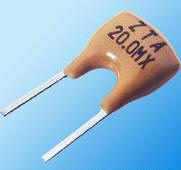Phase Noise
Phase noise is a small fraction of undesirable frequency near the output
frequency, and is usually expressed as the SSB spectral density in dBc/Hz.
Phase noise is dependent mostly on the crystal with the circuitry making
up the unit playing a small role. The
measurement is commonly in the 1 Hz bandwidth.
The description of phase noise is "at x Hz offset it is y dBc/Hz". Low levels of phase noise are achieved through careful
circuit design and use of carefully processed high-Q resonators.
Harmonic Distortion
The non-linear distortion due
to un-wanted harmonic spectrum component related with target signal frequency.
Each harmonic component is the ratio of electric power against desired
signal output electric power and expressed in terms of dBc.
Harmonic distortion specification is important especially in Sine output
when a clean and less distorted signal is required.
Activity Dip
Activity dips result from
mechanical coupling of the principal mode to one or another of a number of
interfering modes, which exist but are not electrically excited by the resonator
electrodes. At some temperature,
the frequency of the interfering modes coincide with the frequency of the
desired mode, energy is lost from the main mode, thereby causing an increase in
the resonator equivalent resistance at that temperature.
Accompanying the activity dip is a deviation of the F vs. T
characteristic from a smooth curve, but this is often much less pronounced than
the resistance increase. In extreme
cases, when the oscillator gain is insufficient, the resistance increase
stops the oscillation over a range of temperature. In addition, even when the resistance increase is not large
enough to stop the oscillation, the frequency change can cause intermittent
failures, e.g., it can cause a loss of lock in phase locked systems.
G-Sensitivity
It is a measure of the sensitivity to acceleration, also known as
Acceleration Sensitivity, which is the frequency shift caused by subjecting the
crystal to a constant acceleration. The
most notable test is the Two G Tip-over test.
Here the G-sensitivity is measured by allowing the oscillator to
stabilize, and the frequency is measured. The
oscillator is then turned upside down, 180º,
and the frequency is measured again. This
test is repeated for each major axis of the oscillator.
The difference in frequency is divided by 2, yielding the static
G-sensitivity. The following table shows the typical g-sensitivity numbers
| Commercial TCXOs |
Commercial OCXOs |
High-reliability OCXOs |
| 5 x 10-9/g |
3.5 x 10-9/g |
2 x 10-9/g |
Vibration Sensitivity
It is the measure of the oscillator sensitivity to vibration.
It can be viewed in two ways: dynamic and static.
Dynamic sensitivity refers to degradation of phase noise due to vibration
while the unit is powered in the target system.
This can be different from the static G-sensitivity number in that the
oscillator may posses an internal structural resonance, which will have a higher
sensitivity as certain frequencies. In
most case, the dynamic sensitivity is not an issue, since typical oscillators
are rack mounted and not subjected to significant vibration levels.
The static sensitivity, also known as sensitivity to transportation, is a
more important factor, as it happens in transit from manufacturer to customer
and is normally outside of the control of the manufacturer.
The shock and vibration can result in shifts in the calibration
frequency, resulting in an offset as the customer.
Packaging and design of the oscillator can help to reduce this effect, so
that the part is still within specification on arrival at the customer site.
|
|
|
|
|
|
HC-49S |
UM-1 |
SMD Crystal 5032 |
|
|
|
|
|
SMD Crystal 2520 |
Crystal Oscillator Through Hole |
SMD TCXO |
|
|
|
|
|
TCXO Through Hole |
SMD VCXO |
Crystal Filter 49T holder |
 |
 |
 |
|
ZTA Ceramic Resonator |
ZTB Ceramic Resonator |
Ceramic Filter |
|
More Details |
 |
 |
China-xtal Co., Limited.
ADD:10HO,UNIT 3,RM 601,BAISHENG HUAYUAN,4HO,ZHANGHUAN RD,
KEYUAN TOWN, ZHANGDIAN, ZIBO, SHANDONG, CHINA
Tel: 86 18678126086 WeChat: +86
18678126086
E-mail:
taylor@china-xtal.com
;
taylor@zbchinaxtal.com;
taylorliang@126.com
http://www.china-xtal.com
;
http://www.zbchinaxtal.com
MSN:
taylor_liang@hotmail.com;
Skype: taylor_liang70 |
|


